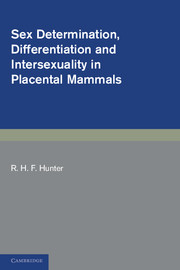Book contents
- Frontmatter
- Contents
- Preface
- Acknowledgements
- List of abbreviations
- List of gene abbreviations
- 1 Historical landmarks in studies of reproduction and sex determination
- 2 Mechanisms of sex determination
- 3 Differentiation of the gonads
- 4 Differentiation of the genital duct system
- 5 Anomalous sexual development in domestic species
- 6 Abnormal sexual development in laboratory rodents
- 7 Abnormal sexual development in man
- 8 Sexual differentiation in chimaeras
- 9 Asymmetries in the reproductive system and their significance
- 10 Concluding thoughts and a current perspective
- Index
- Plate section
9 - Asymmetries in the reproductive system and their significance
Published online by Cambridge University Press: 05 March 2012
- Frontmatter
- Contents
- Preface
- Acknowledgements
- List of abbreviations
- List of gene abbreviations
- 1 Historical landmarks in studies of reproduction and sex determination
- 2 Mechanisms of sex determination
- 3 Differentiation of the gonads
- 4 Differentiation of the genital duct system
- 5 Anomalous sexual development in domestic species
- 6 Abnormal sexual development in laboratory rodents
- 7 Abnormal sexual development in man
- 8 Sexual differentiation in chimaeras
- 9 Asymmetries in the reproductive system and their significance
- 10 Concluding thoughts and a current perspective
- Index
- Plate section
Summary
But the Kers were aye the deadliest foes
That e'er to Englishmen were known,
For they were all bred left-handed men,
And fence against them there was none.
(Hogg, 1830)Introduction
To write a chapter on unilateral phenomena in terms of gonadal development and genital physiology may seem unusual in a monograph assembled under the present title, and especially so in the context of intersexuality. The chapter will accordingly be kept reasonably brief in order to avoid appearing as a diversion. Nonetheless, there is a strong feeling that if one could understand precisely why one side of the body may be privileged in terms of the rate and/or extent of organ development, then some of the frequently noted differences in the reproductive system might be more accessible to a meaningful explanation. This thought particularly concerns differentiation and development of the gonads, for inequalities in rates of growth of the two gonads may find expression in the formation of abnormal tissues, perhaps more appropriately termed anomalous tissues. At the very least, it appears that there may be a unilateral predisposition to potentially wayward development. So, whilst the pages that follow will in due course focus most attention upon the gonads themselves, differences in the form and/or function of the genital ducts – especially in female mammals – will be considered largely to reflect different inputs or influences from the two gonads.
- Type
- Chapter
- Information
- Publisher: Cambridge University PressPrint publication year: 1995

